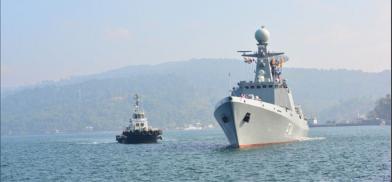For a place at the global high table, India’s maritime strength needs bolstering
The IN has been at the forefront in supporting the country’s security and diplomatic initiatives in the region through extensive bilateral and multilateral interaction, writes Cmdre Anil Jai Singh (retd) for South Asia Monitor

In March 2020, the Indian Navy will host the 11th edition of the biennial ‘MILAN’ (meeting) exercise in Visakhapatnam, headquarters of the Eastern Naval Command, with over 30 navies participating.
Since the first edition, held in 1995 in Port Blair, Andamans, with four South-East Asian navies joining in a cultural and sporting interaction, the exercise has grown exponentially over three decades. MILAN has also grown to include professional and cultural interactions in harbour and basic and advanced exercises at sea. The increase in the scope and scale of MILAN exemplifies the pro-active strides India has taken over the last few years in enhancing its qualitative and quantitative naval engagement with the region and the world.
Notable inclusive capacity and capability building concepts like SAGAR (Security and growth for All in the Region) and Mausam, the ‘Sagarmala’ port and maritime infrastructure initiative, and a clear articulation of India’s overseas interests, including the security of its widely dispersed diaspora, have firmly established its credentials as the predominant power in the Indian Ocean and a regional heavyweight in the emerging geopolitical narrative of the Indo-Pacific. These, coupled with the country’s economic growth and firm adherence to its core values despite external and internal pressure has earned it global respect.
India has also established strategic defence relationships with many countries in the region and beyond, including military cooperation through exercises, training, sale and purchase of military hardware and Fleet visits. As a net security provider in the Indian Ocean, India is the first responder to a crisis in the region, the most recent being the arrival of an Indian ship off Madagascar to provide relief in the wake of the cyclone.
During the 2004 tsunami, the Indian Navy (IN) was the first to reach affected countries in our maritime neighbourhood including Sri Lanka, Maldives and Indonesia. There are many more instances where the country has been at the forefront in providing Humanitarian Assistance and Disaster Relief (HADR), earning it appreciation from governments and people.
The emergence of the Indo-Pacific as a single strategic entity, with a distinct maritime orientation as the name suggests, has led countries in the region to re-orient their strategic priorities towards the maritime domain. China has even changed its historical narrative from a continental to a maritime one in its ‘Mahanian’ pursuit of its global leadership ambition through maritime power.
India too, while primarily an Indian Ocean power, now has to look at a much wider expanse of the seascape. This was clearly articulated by Prime Minister Narendra Modi in his keynote address at the Shangrila Dialogue in June 2018 where he said the Indo-Pacific extends from the shores of Africa to the Americas and highlighted the INs efforts to building partnerships and operate with other navies across the region. .
The IN has been at the forefront of supporting the country’s security and diplomatic initiatives in the region through extensive bilateral and multilateral interaction. Indian naval ships exercise regularly with regional and extra-regional navies to enhance the region’s cooperative engagement capability, improve interoperability, develop Maritime Domain Awareness (MDA) and exchange best practices.
From eight exercises with foreign navies in 2015, the IN participated in over 30 bilateral and multilateral exercises in 2019. Frequent overseas deployments and port visits to friendly countries by Indian naval ships are an effective means of showing the flag and reaffirms the country’s commitment towards promoting an inclusive regional maritime security architecture which respects a rules-based international order and ensures that the oceans remain free and secure for the passage of global trade and commerce, 60% of which passes through the region.
In 2018, IN ships called at more than 60 ports including some in the Atlantic Ocean. In recent years, the IN’s multi-mission deployment, with over a dozen Indian warships operating in different parts of the Indo-Pacific, has also contributed significantly to improved situational awareness. This improves the ability to redeploy rapidly and maintain an effective vigil on the choke points surrounding the Indian Ocean which, from a security perspective, are equally, a strategic asset and a vulnerability for the region.
The Government has recently established the ‘Indian Ocean Region Information Fusion Centre’ (IOR-IFC) to enhance regional MDA, which is a prerequisite for providing effective security. It has signed White Shipping Agreements with 22 nations and more are expected, with liaison officers from member countries likely to be positioned here.
The Indian Ocean Naval Symposium (IONS), that brings together naval chiefs from littoral countries, has grown into an effective regional mechanism to address regional maritime security issues at an operational level and suggest policy options and solutions at the political level. The IONS brings together 24 regional navies, despite their political and ideological differences, on a single platform. This bears adequate testimony to the importance of this construct and the commonality of the maritime domain. The IN’s unprecedented operational tempo coupled with these inclusive cooperative security building initiatives has burnished India’s credentials as a net security provider in the region.
India, given its peninsular geographic conformation, is essentially a maritime nation with over 90% of its trade by volume and 74% by value travelling over the sea. More than 80% of its energy requirements are met from the sea, whether imported or indigenous. Its 7516 km long coastline, large EEZ and maritime infrastructure is a source of livelihood for over 200 million people living close to the sea. It has two adversarial, nuclear-armed neighbours, with maritime aspirations in the North Arabian Sea and the Indian Ocean which pose a serious threat to India’s economic well-being and energy security. A robust maritime security architecture is, therefore, a national imperative and a strong navy its principal component.
In the last few years, however, despite the importance of maritime security, the Government has been deficient in providing the Navy the budgetary support it needs despite this being red-flagged by successive Chiefs of Naval Staff. Navies take time to build. The Navy’s long-term force level planning with in-principle approval of the CCS (Cabinet Committee on Security) is done over a 15-year cycle, based on a capability and threat-based perspective and supported by conservative financial planning to ensure a balanced multi- dimensional force structure capable of meeting contemporary and emerging security challenges.
The Navy’s share of the defence budget is currently languishing at about 13%, well short of the desired 20%. This is insufficient to implement the Navy’s plans; and adverse effects on future force structuring are already becoming increasingly evident. The strain on existing resources will also soon begin to tell on the Navy’s operational preparedness.
India aspires to be a great power with the ability to negotiate from a position of strength and to influence and shape outcomes. From a maritime perspective, India is fortunate to have the required wherewithal for this, be it the strategically advantageous geographical position it enjoys in the Indian Ocean or its inherent strengths as a maritime nation.
However, it is being found wanting in its ability to walk the talk on establishing itself as a naval and maritime power. Its capacity-building initiatives, its reputation as the first responder in humanitarian crises and its commitment to a rules-based international order have effectively showcased its soft and smart power skills but, to be truly effective, these must be complemented by commensurate hard power. As the principal instrument of credible maritime power, therefore, the IN needs to get due attention if India indeed wishes to sit at the global high table.
(The writer is a veteran submariner and VP, Indian Maritime Foundation.)










Post a Comment